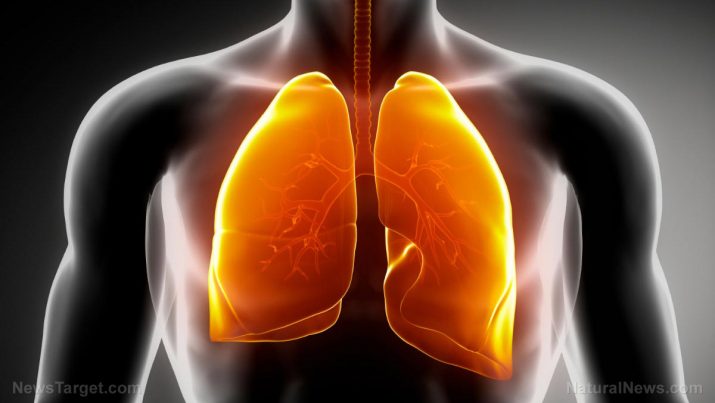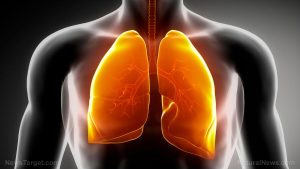
Pulmonary fibrosis – causes, side effects and treatments at NaturalPedia.com
Thursday, June 14, 2018 by Ralph Flores
http://www.naturalpedia.com/pulmonary-fibrosis-causes-side-effects-and-treatments-at-naturalpedia-com.html

The term pulmonary fibrosis (PF) refers to a severe scarring of the lung tissue. Over time, tissues deep within the lungs become thick and stiff, making it difficult for a person to catch his breath. It may also result in the body not getting enough oxygen, which may lead to complications.
Some causes of PF are external, such as environmental pollutants and medication. However, PF can be a complication of other diseases, most common of which is interstitial lung disease, where certain illnesses cause an inflammation, or even scarring, of the lungs.
There are also cases where the cause of the condition is unclear – a condition referred to as an idiopathic pulmonary fibrosis.

Known risk factors and symptoms of pulmonary fibrosis
Idiopathic PF notwithstanding, people who are exposed to certain environments or those who have certain conditions increase their risk of developing PF. These include:
- People who are taking certain medications, such as those to treat cancer and abnormal heart rhythms, including antibiotics for urinary tract infection.
- Those who have had radiation treatments, in particular, in the chest as part of their treatment.
- Chronic exposure to bacteria, mold spores, and animal protein from indoor or caged birds. The condition when the lungs become inflamed and scarred after exposure to these environmental sources is called hypersensitivity pneumonitis.
- Those with autoimmune diseases which affect the lungs such as rheumatoid arthritis and Sjögren’s syndrome, to name a few.
- People who regularly work with inorganic dust like asbestos, silica, beryllium, coal dust, and other types of hard metal.
Common signs and symptoms of PF include:
- Dyspnea, or shortness of breath
- The presence of a dry cough
- Fatigue and unexplained weight loss
- Aching muscles and joints
- Clubbing of the tips of fingers and toes
Depending on its severity, symptoms of PF can progress moderately or rapidly (acute exacerbation). In severe cases, people with the condition may need to be placed on a mechanical ventilator.
Body systems affected by pulmonary fibrosis
If PF is left untreated, the following complications may occur.
- Pulmonary hypertension. As the arteries and capillaries are damaged by scar tissue, this increases the resistance to blood flow in the lungs. This may result in severe progression of the condition which can be, at times, fatal.
- Right-sided heart failure. This occurs when the right ventricle of the heart has to exert more effort to pump blood through blocked pulmonary arteries.
- Respiratory failure. Often the last stage of chronic lung disease, it happens when blood oxygen levels fall dangerously low.
- Lung cancer. Over time, PF can increase the risk of developing lung cancer.
- Complications of the lung. The lung becomes severely affected by the progression of PF. This may result in a collapsed lung, blood clots, and even infections.
Food items or nutrients that may prevent or relieve pulmonary fibrosis
Maintaining a healthy diet is essential in managing PF. Some recommended food items include the following.
- Nuts and seeds are nutrient dense, which is needed to combat unintentional weight loss brought about by PF. In particular, walnuts and flaxseed are also rich in omega-3 fatty acids known to reduce inflammation and promote healthy brain function.
- Fruits and vegetables are filled with antioxidants, which help the body protect itself and recover from disease and infection. Examples of antioxidant-rich fruits and vegetables include berries, cherries, kiwi, cantaloupe, leafy greens, broccoli, Brussels sprouts, cabbage, squash, carrots and bell peppers.
- Whole grains such as brown rice, whole quinoa, pearled barley, and old-fashioned oatmeal, among others are rich in fiber as well as carbohydrates to provide a person with energy.
Treatment and management options for pulmonary fibrosis
While there are treatment courses for PF that require the use of medication, there are also those that require lifestyle changes to manage the condition. These include aerobic condition, strength and flexibility training, nutritional interventions, and psychosocial support.
Where to learn more
- Your Daily Additives – Anticaking Agents – Magnesium Silicate
- Finland unveils drastic plan to make their nation virtually tobacco-free by 2040
- Use Enzymes for Fibrosis, Scars, Keloids, Lung Disease and Cancer
- Healthy sleep habits reduce the risk of dementia among older people
- Yale researchers add “reduction of hearing loss” to the many benefits of NAC supplements
Summary
The term pulmonary fibrosis (PF) refers to a severe scarring of the lung tissue.
Some causes of PF are external, like environmental pollutants and medication. PF can also be a complication of other diseases.
In some PF cases, the cause of the condition is unclear – this is referred to as idiopathic pulmonary fibrosis.
People who are exposed to certain environments or those who have certain conditions increase their risk of developing PF.
Maintaining a healthy diet is essential in managing PF.
Treating PF requires lifestyle changes to manage the condition, including aerobic exercise, strength and flexibility training, nutritional interventions, and psychosocial support.
Sources include:
Tagged Under: Tags: pulmonary fibrosis





